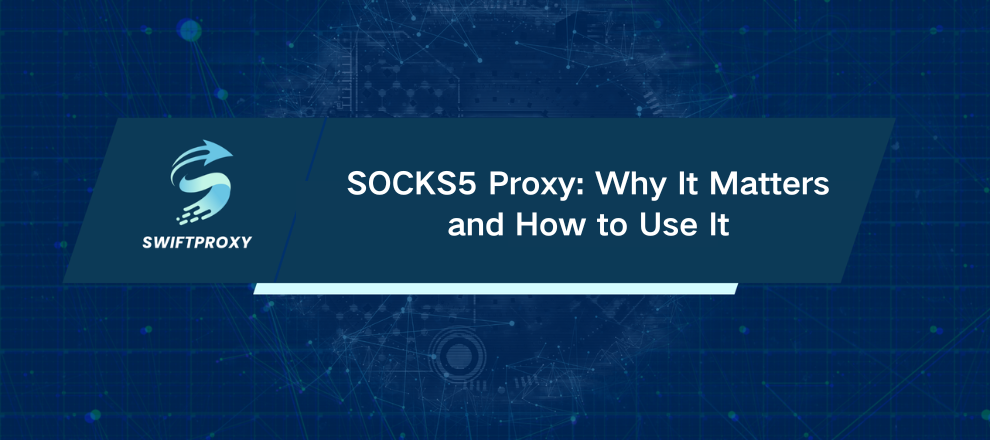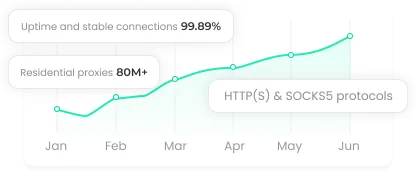SOCKS5 Proxy: Why It Matters and How to Use It
Proxies vary widely in quality and capability. Some are lightning-fast, others excel at maintaining anonymity, but very few can handle every type of connection with ease. That’s where SOCKS5 shines—a versatile solution built for situations where standard HTTP(S) proxies simply fall short. Whether you’re streaming live video, scraping web data at scale, gaming online, or running complex automation, SOCKS5 delivers flexibility, stability, and privacy—without forcing you to rework your setup. Let’s dive in.

Introduction to SOCKS5 Proxy
A SOCKS5 proxy is more than a simple middleman for your internet traffic. Think of it as a skilled traffic conductor. It sits between your device and the internet, relaying data while masking your IP address. The result? Stronger anonymity, reliable connections, and compatibility across nearly any network application.
Here's what sets SOCKS5 apart:
TCP and UDP support: Works with almost any protocol—not just web traffic.
Data labeling: Forward grouped data with tags for analysis or processing.
Encryption-ready: Supports end-to-end encryption if you layer it with secure transport.
Authentication and access control: Use username/password, IP whitelists, or GSS-API.
Transparent routing: Sends packets untouched, preserving headers and structure.
Versatility: Perfect for web browsing, P2P, streaming, gaming, VoIP—you name it.
A SOCKS5 proxy supports IPv6, works with datacenter, residential, ISP, and mobile proxies, and scales depending on workload.
How SOCKS5 Works
The process might sound technical, but here's a simple breakdown:
Connection: Your device opens a TCP link to the proxy.
Method selection: The proxy chooses an authentication method you support.
Authentication and authorization: The proxy checks access rules.
Request formation: You define your operation—CONNECT (TCP), UDP ASSOCIATE, or BIND.
Channel setup: Proxy connects to the target, replacing your IP with its own.
Data transfer: Packets flow back and forth unaltered.
Response and teardown: Connections close cleanly after data transfer.
Unlike HTTPS proxies that only manage TCP and may alter headers, SOCKS5 handles both TCP and UDP without touching your packet structure. That's crucial for apps sensitive to packet integrity.
How to Set Up a SOCKS5 Proxy
Setting one up isn't rocket science. You just need the proxy's IP, port, and authentication details. Here's the quick path for each OS:
macOS: System Settings → Network → Proxies.
Windows 10/11: Settings → Network and Internet → Proxy (or Network and Sharing Center).
Linux: NetworkManager (Proxy tab) or config files like /etc/environment.
Applications often allow direct SOCKS5 configuration. If not, use extensions or system-level tools like Proxifier.
Real-World Applications
Here's where SOCKS5 really shines:
Web scraping and price tracking: Preserves native packet behavior, making detection harder.
Geo-specific content and localization testing: External services see the proxy IP, not yours.
App testing: Supports all ports and protocols—emulate real conditions without code changes.
Secure remote access: Layered with SSH, SOCKS5 routes securely without breaking encryption.
Online gaming: UDP support reduces latency and jitter.
VoIP and video conferencing: Maintains packet order and timing, so calls stay clear.
P2P file sharing: Handles TCP, UDP, and non-standard ports.
Public Wi-Fi: Works seamlessly with TLS, protecting sensitive traffic.
OSINT and filtered networks: Rotating residential or ISP addresses keep operations reliable under DPI or network filters.
Final Thoughts
SOCKS5 proxies offer unmatched flexibility, privacy, and stability, handling both TCP and UDP traffic across nearly any application. From web scraping and geo-targeting to gaming and secure remote access, they let you work efficiently and safely online.

















































